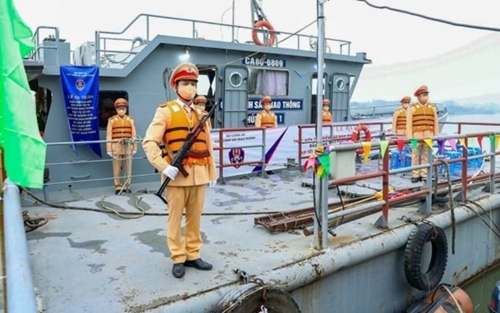According to Decision No.1818/QD-TTg, dated August 25, 2025, the scheme, to be implemented nationwide from 2025 to 2030, is designed to modernize infrastructure and equipment for the waterway police force, thus enhancing their operational capacity. It seeks to build a clean, strong, regular, elite, and modern force capable of ensuring security, order and safety on waterways, supporting transport, economic and social development, disaster response, and national defense.
    |
 |
|
The scheme is designed to modernize infrastructure and equipment for the waterway police force, thus enhancing their operational capacity. |
The plan is also aligned with Vietnam’s strategy for sustainable maritime economic development.
By 2026, one new police waterway port will be built in Quang Ninh province, while three existing stations will be upgraded and seven new ones constructed to modern standards.
The ports and stations will be equipped with modern patrol and surveillance vessels to carry out law enforcement, crime prevention, disaster response, and search and rescue missions in northern coastal and inland waters. Recruitment and training of captains, engineers, sailors, and mechanics will also be undertaken to ensure sufficient personnel for vessel operations.
Beyond 2026, four additional police waterway ports will be built in Da Nang city and Khanh Hoa, An Giang and Dong Thap provinces. Ten existing stations will be upgraded and 32 new ones constructed nationwide. Modern patrol vessels will continue to be procured for missions in central and southern waters, while personnel training and recruitment expanded to strengthen law enforcement, crime prevention, and rescue capabilities across coastal and inland waterways.
Investment scale and locations
Under the plan, one Tier-1 police waterway port will be built in Quang Ninh province, along with 14 stations in the North, including 11 new facilities, and three upgrades.
In the central region, two ports will be developed — a Tier-1 in Khanh Hoa and a Tier-3 in Da Nang — together with 11 stations, comprising 10 new ones and one upgrade.
In the South, two Tier-1 ports will be built in An Giang and Dong Thap, alongside 27 stations, including 18 new facilities and nine upgraded sites.
Five waterway police vessel fleets will be established, each comprising one command ship, two patrol vessels and three high-speed boats, based at the new ports across the northern, central, and southern regions. Additional patrol vessels and boats will be provided for local police.
Training will be strengthened in areas such as inland waterway and maritime law, patrol procedures, accident investigation, and disaster response.
Cooperation with external training institutions will be expanded to provide professional certification for captains, engineers and crew members. International collaboration and study visits to countries with advanced waterway transport systems will also be pursued.
Implementation responsibilities
The decision assigns the Ministry of Public Security to take primary responsibility for drafting, managing, and implementing the plan, including preparing investment projects for police waterway ports, stations and patrol vessels. The ministry will also coordinate with local authorities in land use planning, oversee related ministries and provinces in carrying out assigned tasks, and report annually to the Prime Minister on progress and outcomes.
The Ministry of Finance will coordinate with the Ministry of Public Security and other agencies to arrange state budget allocations and other funding sources for the plan.
The Ministry of National Defence will coordinate in port and station locations to ensure consistency with national defence requirements, while the Ministry of Construction will work with the Ministry of Public Security to align investments with the national waterway infrastructure planning.
Provincial and municipal People’s Committees will also be responsible for working with the Ministry of Public Security to implement the plan in their localities.
Source: VNA